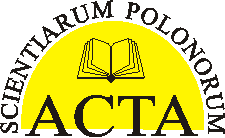Tytuł
WATER ABSORBING GEOCOMPOSITE: A NOVEL METHOD IMPROVING WATER AND FERTILIZER EFFICIENCY IN Brunnera macrophylla CULTIVATION. PART I. PLANT GROWTH
Autor
Katarzyna Wróblewska, Piotr Chohura, Regina Dębicz, Krzysztof Lejcuś, Jolanta Dąbrowska
Słowa kluczowe
container nursery, superabsorbent polymers, plant development, chlorophyll
Streszczenie
Water absorbing geocomposite (GC) consisting of SAP, geotextile and internal skeleton is a novel method of superabsorbent polymer (SAP) and fertilizer application. Roots can overgrow the geotextile and thus obtain access to water. The objective of the experiment was to determine the effect of the geocomposite on the growth of container-grown Brunnera macrophylla. The geocomposite was used as a multi-compound fertilizer (Insol® U) carrier and compared with soluble fertilizer (SF) and controlled-release fertilizer (CRF). The doses of fertilizers were calculated to cover the equal N supply: 0.36 and 0.72 g plant−1. The geocomposite positively influenced the plant traits after 8 and 16 weeks of cultivation. The number of leaves increased by 42% and 60% and the biomass of the above-ground parts of plants increased by 260% and 340% in comparison to plants treated with other fertilizers. The effect of the fertilization rate on plants was weakly pronounced, but a positive influence of a higher dose and the GC combined on all the examined traits of Siberian bugloss plants was detected.
Strony
49-56
Cytowanie
Wróblewska, K., Chohura, P., Dębicz, R., Lejcuś, K., Dąbrowska, J. (2018). WATER ABSORBING GEOCOMPOSITE: A NOVEL METHOD IMPROVING WATER AND FERTILIZER EFFICIENCY IN Brunnera macrophylla CULTIVATION. PART I. PLANT GROWTH. Acta Sci. Pol. Hortorum Cultus, 17(6), 49-56.
Pełny tekst


